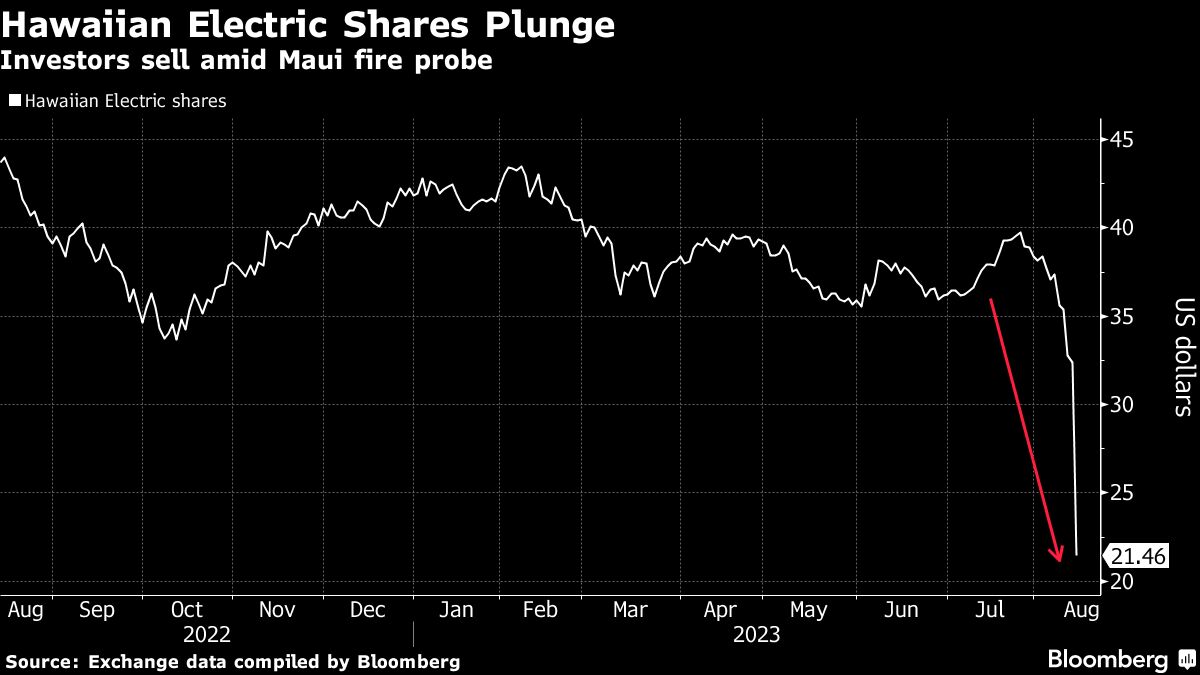(Bloomberg) — The Hawaiian Electric Company, which supplies energy to nearly 95% of the state’s population, traces its roots back to 1891, just a decade after King Kalākaua met Thomas Edison to see the incandescent light bulb. Now, the gadget is facing what is shaping up to be the biggest test ever on its future.
Most Read from Bloomberg
In just one day, the ongoing sell-off wiped more than $1 billion off the company’s value as the stock fell by a third in its biggest loss ever. Investors are dumping stocks amid increasing scrutiny of power equipment as a possible source of a deadly wildfire in Maui.
Analysts are starting to question whether Hawaiian Electric, one of the smallest publicly traded U.S. utilities, will be able to withstand the pressure if it ends up falling foul.
To be clear: No official cause has been determined for the fire, which has become the deadliest in the United States in over a century. It could take weeks – even months – before any investigation is completed.
However, lawsuits have already been filed against Hawaiian Electric amid reports of power lines knocked down by strong winds in the run-up to the fires.
Damage from the tragedy has now come to more than $5.5 billion, according to federal estimates, an amount that dwarfs Hawaiian Electric’s market value by about $2.4 billion as of Monday’s close.
“Given the size of the company, I don’t know how they would be able to calculate that if they turned out to be careless or unwise,” said Shahryar Pouriza, a utility analyst at Guggenheim Securities. “It’s hard to see the company emerge from this tragedy in its current form.”
Honolulu-based Hawaiian Electric, which operates Maui Electric, declined to comment on its share price drop and potential legal liability. The tool said it focuses on restoration efforts, damage assessment and community support.
“At this early stage, no cause has been determined,” the company said in a statement. “We will work closely with the state and county as we conduct the review.”
Lawsuits have been filed on behalf of the victims alleging that the Maui corporation was negligently responsible for the wildfires that destroyed the historic city of Lahaina.
Read more: Why Hawaii’s Power Lines Are Suspected in the Maui Fire: QuickTake
If utilities are liable in a worst-case scenario, Bouriza said, they may have to restructure in bankruptcy, or they could be taken over in a government bailout. In the near term, he said, Hawaiian Electric could face a liquidity crunch as banks are reluctant to lend the company money needed to finance its operations given potential liability risks.
“If you were a creditor to the company,” he said, “I think you would take a step back and say, ‘I’ll wait and see how it goes’.”
On Monday, Guggenheim cut Hawaiian Electric’s price target from $32 apiece to $18, warning it could drop. The shares closed down 34% at $21.46 on the same day.
Read more: In Search of Cause of Hawaii Fires, Lawyers Investigate Power Lines
The company has been criticized for not cutting power despite warnings of critical fire conditions due to expected strong dry winds. The utility said preemptive, short-term shutdowns should be coordinated with first responders. In Lahaina, electricity powers pumps that supply water needed to fight fires.
There is precedent for large wildfire liabilities pushing a facility into crisis and bankruptcy.
California’s largest company, PG&E Corp., was forced to reorganize in 2019 after its wind-damaged equipment caused some of the most destructive wildfires in the state’s history, leading to more than $30 billion in claims. The company was threatened with a state takeover, but eventually reached a Chapter 11 settlement with California that led to closer regulatory oversight of its operations and the payment of billions of dollars in claims for shooting victims.
Read more: Wildfires in Hawaii are becoming more frequent as drought wanes
If there was a connection to the power lines, Hawaiian Electric’s negligence would have to be proven or the loss could have reasonably been prevented, which is a higher legal standard than that applied to California utilities, according to the analysts.
“If there is negligence, I would expect all options, including bankruptcy of Maui Electric, to be on the table,” said Guy Ramm, CEO of Reeves Asset Management. Rhame said Reaves does not have Hawaiian Electric stock in its portfolio.
The company’s insurance coverage is likely to be less than $1 billion, Jonathan Reader, a utility analyst at Wells Fargo, said in a note Monday. It’s unclear whether the parent company can “identify” potential liabilities within its Maui Electric subsidiary, according to the memo.
Meanwhile, traditional utility investors are likely to stay away from the company’s stock, said Andy Bischoff, a utility analyst at Morningstar.
“This is something that will continue for some time,” Bischoff said. “For a utility investor, it probably isn’t a risk profile that they’d be willing to accept,” he said.
Most Read by Bloomberg Businessweek
© 2023 Bloomberg LP

